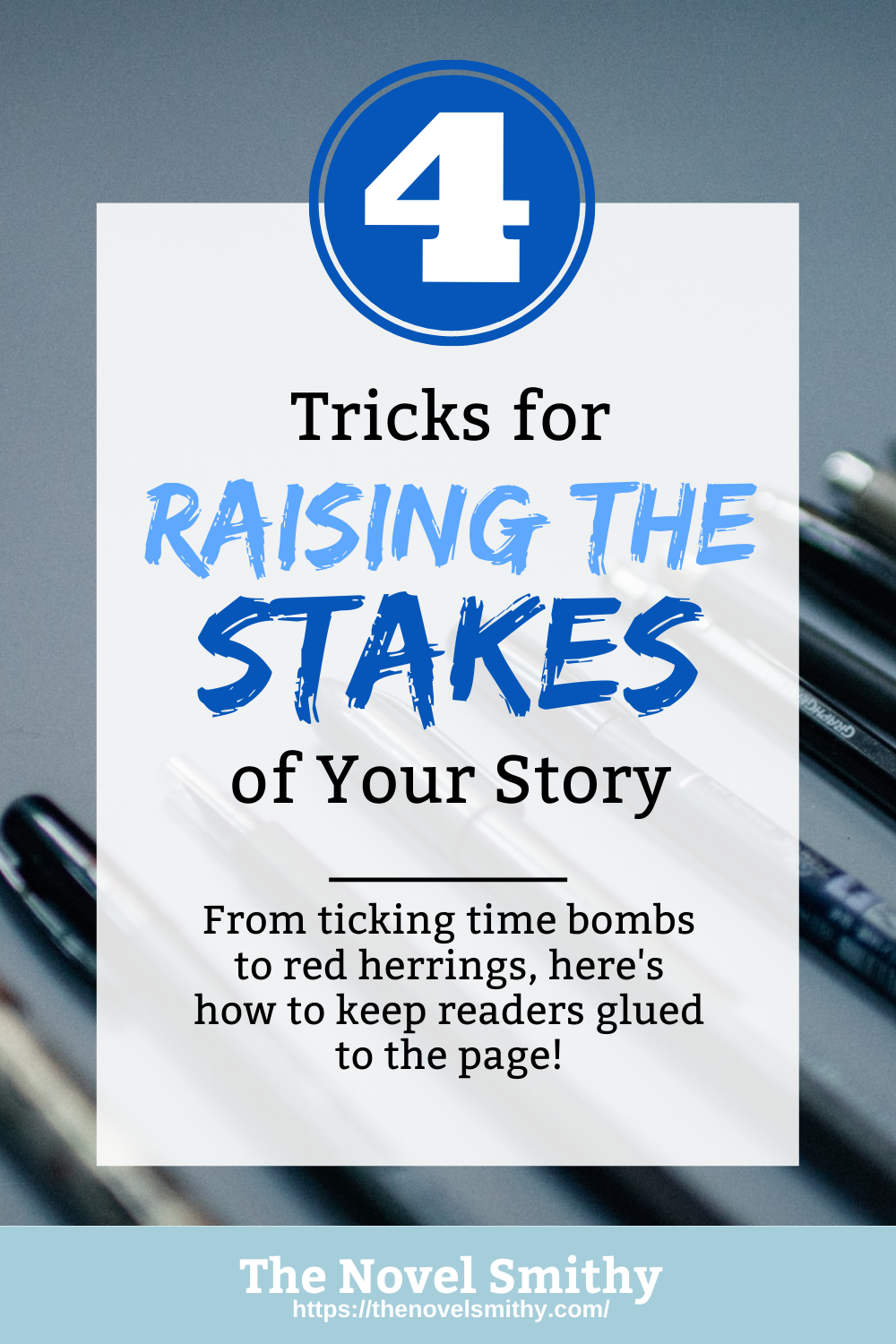4 Tricks for Raising the Stakes of Your Story
When writing a novel, conflict is the name of the game.
From driving your plot forward to creating moments of growth for your cast, your novel’s conflict will play a critical role in shaping your story. Even better, it’ll also encourage your readers to stick around, always wanting to know if your hero will survive their next challenge. However, conflict alone isn’t enough here—instead, you need a conflict with stakes.
These stakes create consequences for your novel, ensuring it’ll leave a lasting impact. The question is, how do you raise the stakes of your novel, even in the slower moments of your plot? Well, the key is to leverage a few simple storytelling tricks—so, from ticking time bombs to red herrings, let’s talk about four ways to raise the stakes of your story!
Why the Stakes of Your Story Matter
Contents
 First up, we should define what “stakes” actually are.
First up, we should define what “stakes” actually are.
Put simply, the stakes of your story are the consequences your protagonist will face if they fail to overcome your novel’s conflict. With the right stakes, readers will keep reading to see how your novel is resolved, because they know your hero has something to lose. Likewise, this also ensures your conflict has enough tension to remain interesting. Your protagonist has to earn their success, and if they fail, they’ll suffer because of it.
So, how do you create these meaningful stakes?
Well, it might seem like you need an endless barrage of derailed trains, massive explosions, and high-octane action, but really, the stakes of your story could be as simple as losing a pet or being passed over for a promotion.
This means that, to raise the stakes, you first need to identify what stakes work for your novel:
- What does your protagonist fear most?
- What does your protagonist want to achieve and why?
- What do they value above anything else—and thus would be crushed if they lost?
- How do these tie into your novel’s conflict, and how can you leverage them to create stakes?
In total, your novel will likely have one or two major stakes (such as remaining a beast forever, a la Beauty and the Beast) as well as a series of smaller stakes (such as being embarrassed in class or crashing during a test flight). Either way, once you have a solid idea of the various stakes of your story, you can start exploring ways to raise those stakes in exciting ways!
4 Ways to Raise the Stakes
Ticking Time Bombs:
First up, ticking time bombs are a classic way to raise the tension of a story by adding a hard deadline. Essentially, these ticking time bombs act as timers within your novel, counting down to a major event and the dire consequences that come with it—much like diffusing a bomb!
For example, your protagonist might have until dawn to alert their unit of an oncoming attack, knowing that if they fail their friends will be wiped out. In a similar vein, your hero might only have until midnight to leave the ball before their magical disguise disappears, or they may have to reach their escape pod before the oxygen in their ship runs out in just thirty minutes.
Of course, when writing a ticking time bomb, there are a few things to watch out for.
For starters, this timer needs to feel like a natural aspect of your story, not like something you added at the last minute. Additionally, you’ll also want to strike a balance—too long of a time limit and your story won’t have the tension it needs, since your characters can easily “diffuse” the bomb in time. However, if the timer is too short, you also might write yourself into a corner.
Ultimately, you want your characters to have just enough time to logically succeed, while still being short enough that your readers are left sweating—just a little!
Red Herrings:
Next, we have the red herring.
“A red herring is a piece of information that misleads or distracts the reader (and sometimes the character) from an important truth or leads them to mistakenly expect one outcome over another.” – Red Herrings: How to Mislead and Surprise Readers
If you’ve never heard this phrase before, it comes from the early 1800s, when an English journalist popularized a story about how he used smoked herring to throw hounds off his trail as a child. These days, the term red herring is used to describe clues you leave in a story to distract readers from the real answer—and as a result, it’s a popular tool in everything from thrillers to mysteries and action novels.

Red herrings are great, because they can be used to raise the stakes when characters think they’re on the right track, only to find their plans keep failing. They simply don’t have the right information.
Unfortunately, red herrings can also be tricky to pull off—even if the payoff is worth it.
You see, red herrings need to be placed strategically in order to present readers with a false solution, thus distracting them from the truth that’s hidden beneath their noses. Any red herrings in your novel have to be set up with care to ensure the big reveal still feels like a logical outcome of your story.
Likewise, you don’t want to leave out information just for the sake of creating a red herring. Instead, focus on ways to downplay the clues you don’t want readers to pay attention to, while simultaneously highlighting the ones you do. In the end, readers should be able to look back and piece together the clues they missed, rather than feeling like you lied to them!
Dramatic Irony:
Sometimes you want your readers to know something your characters don’t, and that is where dramatic irony comes into play.
At its core, dramatic irony is when you reveal information to your readers, while simultaneously leaving your characters in the dark. This means readers are left waiting for the next shoe to drop, practically shouting at your cast to realize what’s happening—thus creating a heightened sense of stakes for your story.
What’s more, this dramatic irony can be used in a ton of ways, such as by:
- Letting your characters make mistakes due to a lack of info
- Having them bare their heart to someone they wouldn’t otherwise
- Keeping readers on edge as they wait to see when your cast realizes the truth
- And having characters get to know each other before revealing their true identities
Of course, like with every other technique we’ve discussed, you need to be careful when creating dramatic irony in your novel.
For starters, sometimes you want to surprise readers right alone with your characters, in which case dramatic irony is best avoided. Likewise, you’ll need to focus on show don’t tell when creating dramatic irony—don’t simply say “Carol was Samantha’s secret crush from highschool, but they didn’t recognize each other.” Instead, you’ll need to clue perceptive readers into the truth, while still leaving room for them to discover it on their own.
Finally, you want to avoid going overboard when creating dramatic irony. While this is a great way to raise the stakes of your story, you can easily frustrate readers if it seems like your characters will never catch the hint. So, practice moderation, and make it clear why your cast doesn’t realize the truth just yet.
A Personal Connection:
Finally, when all else fails, you can always raise the stakes of your story by ensuring your characters will be personally affected by your novel’s conflict—ie, that your stakes have immediate, visible consequences within their lives.
For example, perhaps your protagonist has to pass their college midterms or risk losing their scholarships, thus forcing them to drop out of school and give up their career. Or, maybe your protagonist has struck a deal with an intergalactic kingpin, where if they fail to deliver on their end of the bargain, they’ll end up losing their head.
Of course, these stakes don’t have to involve physical loss or danger.
Instead, failure might force your hero to ask difficult questions about their world or themselves, meaning the stakes of failure would be purely internal. Still, those stakes could be just as meaningful as the threat of death—being forced to question core beliefs nearly always creates deep psychological stress, even if it’s a key part of their character growth.
Exploring the Stakes of Disney’s Beauty and the Beast
Now, with all that said, let’s take a look at a story that uses its stakes to their fullest—that being Disney’s Beauty and the Beast. This movie is an excellent example of raising the stakes, as it actually leverages multiple of these techniques to ramp up the tension throughout the story.
If you’re not familiar with the movie, the basic premise is that a prince is cursed by a sorceress after he refuses to offer her shelter, saying she is too hideous to deserve his help. As punishment, she curses him to become a beast, telling him the only way to end his curse is to earn true love before his 21st birthday—signified by an enchanted rose that slowly wilts as the deadline approaches.
Immediately, you should be able to see a few techniques at work here.

By far the most obvious is the ticking time bomb, represented by the enchanted rose. The movie highlights this rose regularly, always reminding the audience that the Beast is running out of time.
However, this movie also leans into its dramatic irony. We know the terms of the Beast’s curse, but Belle—the woman he grows to love—does not. This means that, when the Beast fumbles or draws Belle’s ire, we feel a certain sense of tension. We want to see the Beast grow into a better person and ultimately succeed, meaning we care about the consequences of his story.
This is dialed up to eleven by the end of the film.
Here the Beast agrees to let Belle leave to be with her dying father, despite knowing his 21st birthday is only days away. The stakes are at their peak here, with the audience practically screaming at Belle to stay with the Beast—even as we love the Beast for putting her needs above his own. This way, when Belle returns at the last moment, the stakes are at an all-time high. The Beast literally has just moments left.

Finally, this movie also does an excellent job establishing a strong personal connection between the Beast and the stakes of his story. While he starts out arrogant and aggressive, we soon learn that he feels deeply guilty for condemning his servants to be cursed as well. Combine that with the fact that he puts his love for Belle above his own desires, and we get a hugely impactful moment of catharsis—all while the stakes of the story add to the tension.
If you’re curious why I described this movie as the Beast’s story and not Belle’s, this video offers a great explanation.
How to Create Stakes, No Tricks Required
With that said, adding stakes to your story through the techniques we’ve discussed won’t always work. Sometimes they simply won’t fit the story you’re writing, and even if they do, you might need to create additional, smaller stakes to fill the lull between major plot points.
Still, you need stakes to keep readers engaged—so, how?
Well, the key is by leveraging scene and chapter structure. If you’re not familiar with these, they’re two forms of story structure that focus on the smaller units of your story. Scene structure ensures your scenes are linked by common scene goals, while chapter structure helps organize your chapters to create a steady increase in tension from beginning to end.
Best of all, these storytelling tools are a great way to introduce what editor Savannah Gilbo calls “progressive complications.” These are the small conflicts that arise throughout your story, with each successive one making it harder for your hero to achieve their goals.
By raising the stakes of your story, readers will stick around, because they know your hero has something to lose. #amwriting Share on XFor instance, your protagonist might be sneaking into the villain’s lair but find their route is blocked, then realize they need a key card to get through, and then learn the only card is with the head guard. These smaller conflicts steadily build in intensity, thus creating the sense that the stakes are always rising. Combine that with well-built scenes and chapters, and you’ll have a series of progressive complications that keep readers on their toes!
So, while you shouldn’t ignore the four tricks we’ve discussed, don’t worry if they don’t work for you. You can always lean on scene and chapter structure to fill in the gaps.
You can find more on these two structures here:
- The Basics of Scene Structure: Action and Reaction
- Chapter Structure: How to Write the Perfect Chapter
It’s All About Conflict!
At the end of the day, creating meaningful consequences in your novel is key if you want to write a story readers will care about.
Fortunately, raising the stakes of your novel isn’t an impossible task, especially once you have a solid grasp on your novel’s conflict. From there, it’s simply a matter of understanding how that conflict will impact your characters and their world, and then highlighting those stakes through a few handy storytelling techniques. 🙂
If you’d like to learn more about creating story conflict and motivating your cast, you can check out these articles for extra tips and advice:


This is brilliant. It pulls lots of things together for me in a very useful way. Thank you for this. Running out of time brings up a crucial point that had not occurred to me. This has given me three helpful ideas that will be really important in making the story more gripping.
Hi Freda,
I’m so glad I could help! And you’re absolutely right. Having a time limit can definitely add a wonderful sense of tension to a story. 🙂